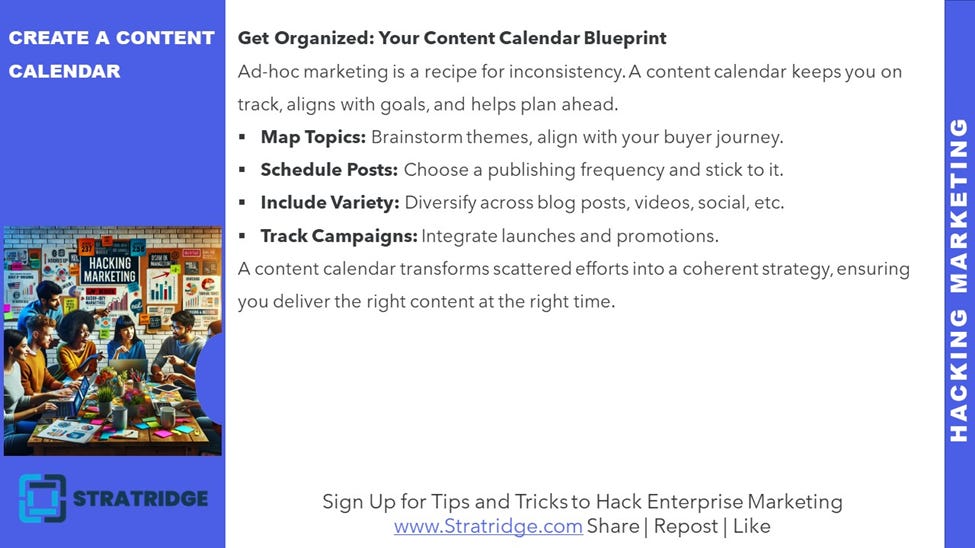In the realm of digital marketing, consistency is key to maintaining visibility and engagement. One of the most effective tools for achieving this is a content calendar. A well-structured content calendar not only organizes your marketing efforts but also aligns them with your strategic goals, ensuring that you deliver relevant, timely, and diverse content to your audience.
The Importance of a Content Calendar
A content calendar is essentially a roadmap for all your content marketing activities. It serves several vital functions:
Ensures Consistency: Regular updates keep your audience engaged and help maintain a steady presence across all channels.
Aligns with Marketing Goals: Helps strategize content around product launches, promotional events, or key dates in your industry.
Facilitates Team Collaboration: Provides a shared tool for planning and tracking tasks, making it easier for teams to collaborate and meet deadlines.
Improves Quality Control: Allows for advanced planning, which means there's more time for content creation and review, enhancing the quality of the output.
Components of a Content Calendar
A comprehensive content calendar should include several key elements to be effective:
Content Themes and Topics: Start by mapping out key themes or topics that resonate with your audience and align with your brand's messaging. This could be guided by buyer personas, seasonal trends, or industry events.
Content Types: Incorporate a variety of formats, such as blog posts, social media updates, newsletters, videos, podcasts, or infographics. This diversity helps cater to different audience preferences and maximizes engagement across platforms.
Publishing Frequency: Decide how often you want to publish content on each channel. It's important to strike a balance between maintaining visibility and overwhelming your audience.
Key Dates and Campaigns: Integrate product launches, promotional events, and other marketing campaigns into your calendar. This ensures that all content is strategically aligned with your business objectives.
Responsibilities and Deadlines: Assign clear roles and deadlines for content creation, approval, and publication. This clarity is crucial for smooth execution and accountability.
Steps to Create a Content Calendar
Creating an effective content calendar involves several strategic steps:
Audit Existing Content: Review your current content to determine what has been successful and what gaps might exist. This audit will inform your content strategy moving forward.
Define Your Goals: Align the calendar with overarching business and marketing goals. Whether it's increasing brand awareness, driving more web traffic, or generating leads, your content should directly contribute to these objectives.
Brainstorm Content Ideas: Gather your marketing team for brainstorming sessions to come up with content ideas that support your themes and goals. Consider customer pain points, frequently asked questions, and industry trends as starting points.
Plan the Calendar: Use a tool or platform (like Google Calendar, Trello, or specialized content planning software) to lay out your content schedule. Include all the components listed above—themes, formats, frequencies, and responsibilities.
Establish a Workflow: Determine the workflow from content conception to publication. This includes steps for content creation, review, approval, and posting. Make sure everyone involved knows the process and their specific responsibilities.
Best Practices for Managing a Content Calendar
To maximize the effectiveness of your content calendar, consider the following best practices:
Be Flexible: While consistency is important, so is flexibility. Be prepared to adjust your calendar based on performance analytics, shifting market trends, or unexpected opportunities.
Regular Reviews and Updates: Schedule regular reviews of your content calendar to ensure it remains aligned with your marketing goals and adapts to any new changes in strategy or market dynamics.
Utilize Analytics: Leverage analytics to track the performance of your content. Insights gathered can help you fine-tune your strategy, like identifying the best times to post or the most engaging content types for your audience.
Encourage Team Feedback: Make it a collaborative effort. Regular feedback from your team can provide new ideas and insights that enhance content quality and effectiveness.
A well-maintained content calendar is a cornerstone of successful content marketing. By organizing and planning your content production, you not only ensure a consistent and strategic approach to content delivery but also enhance your ability to engage and expand your audience effectively. With the right preparation, a content calendar can transform scattered marketing efforts into a cohesive and impactful strategy, driving your business toward its goals.
For more marketing tips, tutorials, templates, and tricks, please subscribe to https://www.stratridge.com


